Have you ever wondered if an Air Purifier is something you should have in your home? Are you curious about how or if they actually work? Air quality is arguably one of the most important topics of discussion when it comes to health and wellness. Air is the one thing we cannot live without. We breathe it all day everyday and our lungs are incredibly important to our overall health. They are something we want to take good care of because they work around the clock transporting oxygen to our bloodstream. The best way to ensure you aren’t compromising the health of your lungs is by ensuring they aren’t breathing in any harmful toxic contaminants. We certainly know to avoid things like smoking and fumes, but it goes beyond that. Here are the health benefits of air purifiers in your home is an important step in protecting you and your families health.
* This post may include affiliate links. This means that products purchased from certain links will generate a small commission (At no extra cost to you). As always, I will only recommend brands that have passed my seal of approval and that I truly love. Thank you for supporting this little holistic space on the internet. *
Historically, humans were meant to live outside in Nature. Unlike our homes, the outdoors has its own set of filtering processes thanks to Mother Nature. Even though modern times produces a heavier load of pollution than ever before, the trees constantly renew the quality of air outside. While our homes serve as protection from the elements and intruders, the concept of living in a box with four walls isn’t quite a perfect science as it pertains to our health. The house being stuffy” is a common complaint in these modern house dwelling times and that truly comes down to how well we manage the quality of air we are living in.
What is an Air Purifier? How do they actually work?
One of the most effective ways to manage indoor air quality is by introducing an air purifier to your home. An air purifier is a device that helps clean or filter indoor air of harmful contaminants. They work by using a fan which draws the air into the device and passes through a set of filters that act as a trap for contaminants. The filters grab onto the contaminants and allow the clean air to re-circulate back into the room. There are a number of different companies out there, but choosing the best purifier comes down to:
- the type of filters used
- the number of filters within a unit
- the amount of air they draw (often measured in cubic feet per minute)
- their efficiency level for removing contaminants
- their Clean Air Delivery Rate (CADR)
- size and design of the unit itself
- the contaminants they target
- special features and accessories of the unit
Health Benefits Air Purifiers
There are so many health benefits of air purifiers. Air purifiers promote health and wellness by reducing the health issues that result due to poor indoor air quality. Experts have estimated that close to 50% of all illness is due to poor air quality, and this would make sense as the lungs are an integral part of our health. We take in 20,000 breaths every single day, and any toxins that pass through our lungs are subsequently circulated to other major parts of the body such as the heart, liver, kidney, brain and other vital organs. According to the World Health Organization, “long term exposure to ambient particulate matter (PM) concentrations lead to marked reduction in life expectancy.”
When you look at health from a holistic lens, everything is connected. The body is not compartmentalized into sections separated from each other, rather, they work together and influence each other in harmony. When one organ is struggling, there tends to be a domino effect. Sometimes these effects are obvious, sometimes they aren’t. It’s important to remember that the body is the sum of all it’s parts.
In Traditional Chinese Medicine (TCM), every organ has a series of ailments associated with it. TCM Doctors diagnose which organs are struggling by looking at the entire picture. By looking at the domino effects of symptoms they are able to determine which organ to strengthen. The lungs in particular are seen as a sort of “gateway” between the external world and our internal body. Lungs will continue to take in air for us regardless of the presence of air borne particles and are often left to try and filter out too much. Filtering out contaminants is certainly part of their job, however, over time this can become burdensome. When faced with high levels of particles, the lungs will inevitably allow some contaminants to make their way into other systems of the body if not careful.
Having an air purifier takes the burden of detoxing off of lungs and the body by filtering out contaminants BEFORE they even reach them. The lungs can then maintain their primary function of transporting oxygen into the bloodstream efficiently rather than working against particulate matter. We’ve probably all seen the effects of poor lung function in someone we know, whether it was a relative that smoked their entire life or someone who lived in a mold filled home. Regardless, it’s hard to negate the importance of maintaining a home with clean air to breathe. High levels of pollution can certainly create a decline in wellness.
There are many health benefits of air purifiers being used in the home. Air purifiers can:
- alleviate allergy symptoms
- reduce asthma in those affected
- lessen seasonal illness due to reduced viral and bacterial load in the environment
- reduce mold sickness symptoms
- reduce dust particles (which commonly harbor mold)
- remove harmful smoke from cigarettes or soot from burning candles
- improve overall lung health and breathing
- reduce pollution coming in from outdoors (ie. hazardous smoke from forest fires)
- support healthy sinus cavities
- Improve sleep quality
- Reduce unpleasant indoor odors
- reduce eye irritation
- Lessen exposure to harmful chemicals like VOC’s in the environment which are linked to serious chronic disease like cancer
Volatile Organic Compounds
One important role of an air purifier is to reduce Volatile Organic Compounds (VOC’s). These are chemicals that are added during the manufacturing process of a variety of objects within a typical home. That smell you experience when you bring home new furniture is actually an off gassing process. Chemicals like formaldehyde or fire retardants are added for a number of purposes but they aren’t great for our health. VOC’s are continuously linked to cancer among other chronic health conditions. If we reduce the number of VOC’s in an indoor environment, we reduce a possible contributing factor of a major illnesses down the road. The general rule is to try our best not to let our toxic cup overflow.
Nearby Forest Fires and other Outdoor Air Pollution
The air in a home can be 100 times more toxic than outdoors, but there are circumstances in which the opposite is true. We all saw the devastation of the vinyl chloride spill in East Ohio last year when a train was derailed. We were also grateful that we owned air purifiers when our area was downwind and became the recipient of hazardous smoke during a large forest fire outbreak last year. Our air purifiers worked incredibly well to keep smoke particles from overwhelming indoor air space and lodging into our lungs. Having that extra layer of protection, particularly for my Children, was comforting.
It is inevitable that the air from outdoors will make its way into our indoor environment from time to time. Sometimes this is helpful if the outdoor air is fresh, but there can be times of high contamination. Houses aren’t constructed perfectly air tight on purpose, that would be bad for overall ventilation. But with that comes the possibility of contamination when pollution increases in certain instances. This could even be the case for those who live in densely populated cities like Toronto or New York, where opening the windows isn’t necessarily a better option than indoor air.
Mold Exposure
There are a very wide range of symptoms that are associated with mold exposure and it can be difficult to undo the impacts. Most households have some minimal level of mold growth, however, that can change if you experience higher than normal humidity levels, pipe leakage, basement floods, etc. These conditions create an environment for mold to thrive, growing easily and rampantly.
When mold grows, it creates spores which float into the air we breathe. These spores are what humans react to when exposed and can create steep negative decline depending on the level of exposure. Whether you are using an air filter to prevent mold spores from collecting in the air, or as part of a remediation process, some air purifiers can successfully filter them. This would not be the only step you take in a full remediation process but a helpful tool. Removing mold does not always account for the spores left behind in the air space. Hiring a mold savvy remediation company is incredibly important as they are trained and equipped to section off and vent the area outside to prevent spores from releasing back into the home. You don’t want to agitate mold during remediation as this can leave you with spores amongst your living space even finding their way into your HVAC system.
More on this topic another day. That being said, an air purifier is a great tool to help alleviate spores from remaining within the home and creating havoc on your health. Ensure you look for a purifier that is independently tested against mold spores so you know it is effectively eliminating them from the air you breathe.
Radon Gas
Radon is a toxic gas, it’s impossible for humans to detect as it is invisible, tasteless, and odorless. Radon occurs naturally in soil, rock and water. When other radioactive elements break down underground, they can release radon gas which leak into buildings above. When radon particles get lodged into the lungs they can damage your DNA and lead to cancer diagnosis over time. Radon is known as the second leading cause of lung cancer in North America. Similarly to Mold, Children are more susceptible to radon damage as they have smaller lungs and more years ahead of them as it pertains to current exposure. Ensuring they aren’t exposed to radon gas from the start is the goal. Many homes, schools and work places have levels of radon above what is recommended by regulating health agencies.
You can request radon testing or even add a radon monitor to your home if you want to monitor it’s presence. Thankfully, there are solutions in the form of air purification systems. An air purifier that contains a carbon filter will be able to successfully reduce or eliminate radon gas from the air in your home.
Which Air Purifier We Use in our Home: A Full Review
After scrutinizing over multiple websites, companies, and options, I eventually landed on an Air Doctor. It was about 4 years ago that I purchased my very first model from them and it’s still going strong keeping our home safe. It can be an overwhelming process to try and comb through the number of air purifier models on the market. It took me quite some time and while I suggest you do a little digging on your own to compare between options, I wanted to share the reasons on why we landed with Air Doctor for our family home.
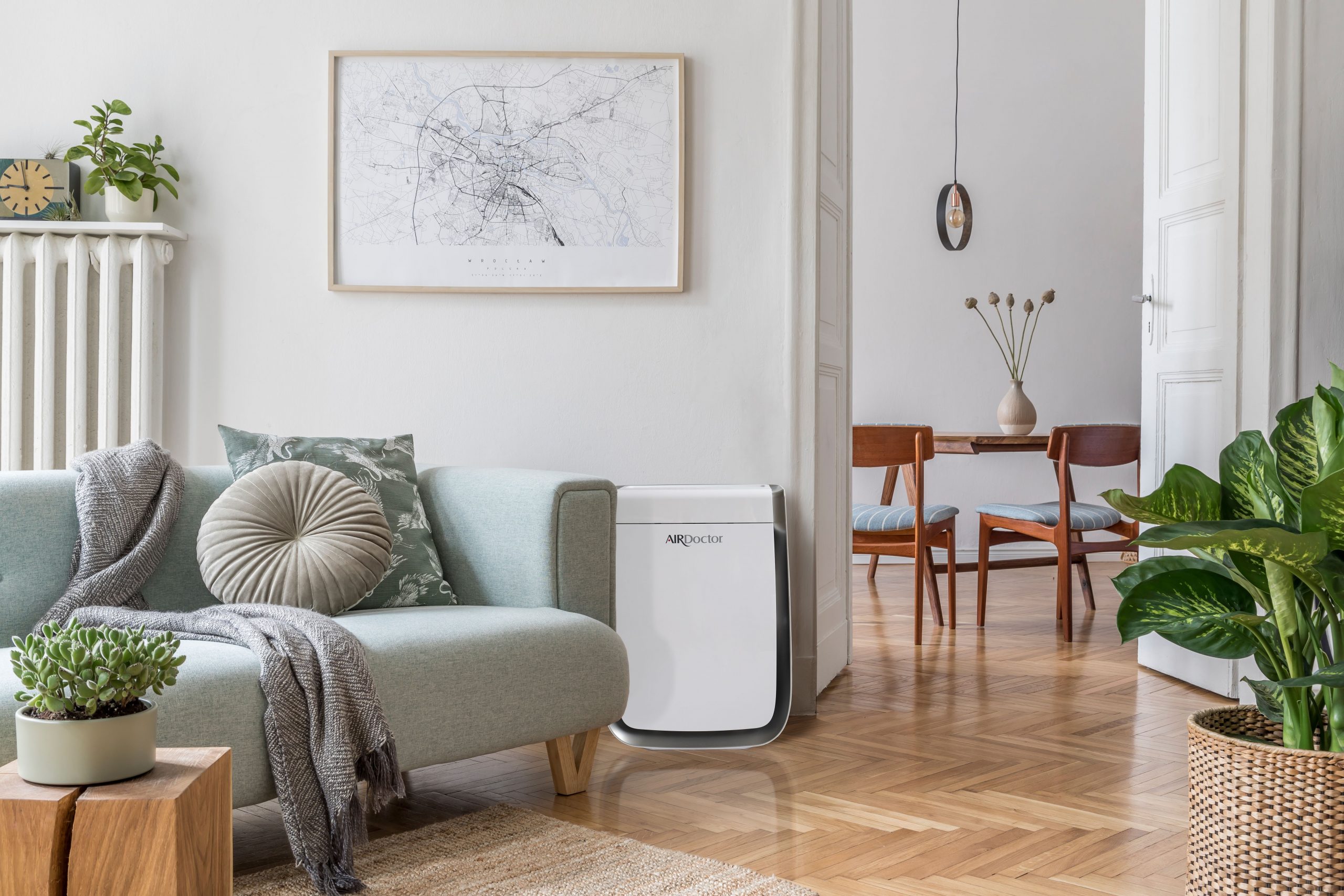
1. Good Quality yet Affordable
When it comes down to choosing an air purifier, a main goal should be to find something of high quality yet still affordable. This isn’t always an easy task as these units can run up into the thousands. After countless hours researching and becoming a bit of an “amateur expert” on air purification, I realized quite quickly that the Air Doctor offers top level technology while also making the units affordable. Many company’s of similar quality have a much higher price tag and are unfortunately out of reach for most families. Affordability is important when it comes to accessibility, but you also didn’t want to compromise and end up with a purifier that does not work. Air Doctor prioritizes affordable solutions without compromising on quality. This is something I commend the brand for and appreciate as a consumer.
Air Doctor delivers the most approachable, affordable professional air purification technology on the market, so our customers can thrive in health, wellness and life. We obsess over every detail and go the extra mile to test and earn third party validation, so anyone can have peace of mind that the air they breathe is as pure as the science that goes into our solutions. – Air Doctor’s Mission Statement.
2. Professional Grade Filtering Technology
As mentioned above, there are many different types of air filters on the market. It’s very common that the air filters you can buy these days are typical HEPA filters. HEPA filters are great but they aren’t what I would deem the best option on their own. If you’re looking to trap some allergens and pet hair, then a standard HEPA does the trick. But that isn’t the whole picture when it comes to air purification. Nowadays, there are advancements in the world of air filtering that go far beyond your run of the mill HEPA. Air Doctor uses more than one technology in it’s units. Air Doctor purifiers are comprised of the following:
- State of the Art H13 Ultra HEPA® Filter’s that have been independently tested to remove particles as small as 0.003 microns. This is 100 times smaller than what a standard HEPA filter manages. These filters remove 99.9% of bacteria and virus from the air.
- Dual Action Carbon Gas Trap/VOC Filters remove odors, ozone, gases and volatile organic compounds like formaldehyde.
- An Ionizer works to produce negative ions which boost filtration performance by influencing contaminants to “clump together” making them easier to capture. You have the option to turn this feature ON and OFF, as some are concerned with an ionizers ability to release ozone.
- An Air tight Sealed System filter frame which ensures all air passes through the unit without any leakage, forcing the air directly through the system. This ensures the air you’re re-circulating is actually clean and not leaking out before the process is complete.
- Lastly, they contain a Professional Grade Air Quality Particle Sensor which continuously assesses the air quality in a room and can immediately adjust filtering level to ensure top level air quality. There is no guesswork, you will see a small ring light on the front of the unit change colors if air quality fluctuates. The Air Quality Indicator will turn blue for good quality, orange for moderate quality and red for poor quality. If the quality isn’t in the blue (good zone) then the purifier will adjust filtration automatically until the contamination has been captured and levels have come down again.
3. Third Party Testing
Third party testing is something you should look for when vetting a brand. It plays such an important role for us as consumers. Third party testing means the brand hired an independent organization to review the manufacturing process of a product and determine that the final product works as indicated. This validation and accreditation from an unbiased source provides a report that proves the product will work the way the brand has marketed. It can be difficult as a consumer to take the word of a company when business and dollars are involved. It is really helpful to rule out transparency issues when there is third party testing involved. Not many air purification companies offer this type of assurance.
When it comes to air filtration, it isn’t exactly possible to visibly see the purifier filtering the air. You will surely notice a difference using Air Doctor, however, there is peace of mind that comes along with third party certification. All Air Doctor units are validated for their performance and ability to filter indoor air at a professional grade level.
4. Full Transparency of Independent Laboratory Testing Results
I wanted to share exactly how in depth the third party testing is and the range of contaminants that Air Doctor models can eliminate from the home. Air Doctor models are tested and proven to successfully remove the following contaminants from indoor environments:
- Dust
- Pollen
- Pet Hair & Dander
- Mold Spores
- Cigarette Smoke
- Viruses
- Bacteria
- Radon Gas
- VOC’s or Volatile Organic Compounds (example: off gassing chemicals from furniture)
- Odor (ie. from cooking or pets)
- Dangerous Ozone
Not all air purifiers on the market are able to eliminate this list in it’s entirety. They often use standard HEPA filters which work on some contaminants but not others. It all boils down to the filters ability to capture contaminants based on their particle size. Air Doctor uses an H13 Ultra HEPA® Filter system, which is independently tested to remove particles 0.003 microns in size. That’s 100 times smaller than the HEPA standard and encompasses all contaminants listed above as their particle sizes are larger therefor easily captured by Air Doctor.
During testing, it was found that the Air Doctor units captured 99.9% of virus and bacteria from the air. As I’m sure many Mothers can relate, this was an incredibly profound statistic to come across as we prefer to keep the “petri dish” at bay. While it is inevitable (and even important) to get the odd illness from time to time, we don’t want to necessarily be exposed to more than necessary. This can be especially helpful during Fall and Winter months when humidity goes down creating a better environment for virus and bacteria to thrive. If you or your family are constantly getting sick, it may be helpful to look at your surrounding environment. I’ve heard from a few people who noticed recurring illness reduce when they began filtering their indoor air space.
In 2020, Air Doctor conducted independent laboratory testing to look at the units efficiency against the Covid virus. They found that the Air Doctor was able to capture 99.97% of Covid viral particles from the air. You can find the full report here, but this was the summation of their findings below:
Our independent laboratory testing conducted by U.S.-based MRI Global, an independent, not-for-profit contract research organization, conclude that Air Doctor 3000 purifier was successful in capturing aerosolized SARS-CoV-2 virus in a test chamber.
It’s safe to say based on the independent test results that Air Doctor purifiers are of professional grade quality and truly are keeping your home safe. With a background in research, I felt very confident reading through these laboratory reports and knowing that there is science backing the function of these air purifiers.
5. Special Features/Accessories
Air Doctor’s are equipped with some extra features that make their usage more convenient, user friendly, and provides some extra information to keep you informed of the filtering process.
- Quiet Mode: Air Doctor’s use whisper jet fans which are 30% quieter than typical fans found in other air purifiers on the market. This means you can enjoy a peaceful environment while benefitting from clean air.
- Change Filter Alert: Air Doctor’s are equipped with Indicator lights that turn on when they need replacing. ** Note: you can actually extend the life of your filters and save some money by vacuuming the filter once per month. By opening the front casing to easily access the filter, simply run a standard handheld vacuum attachment to remove any excess dust or contaminants. **
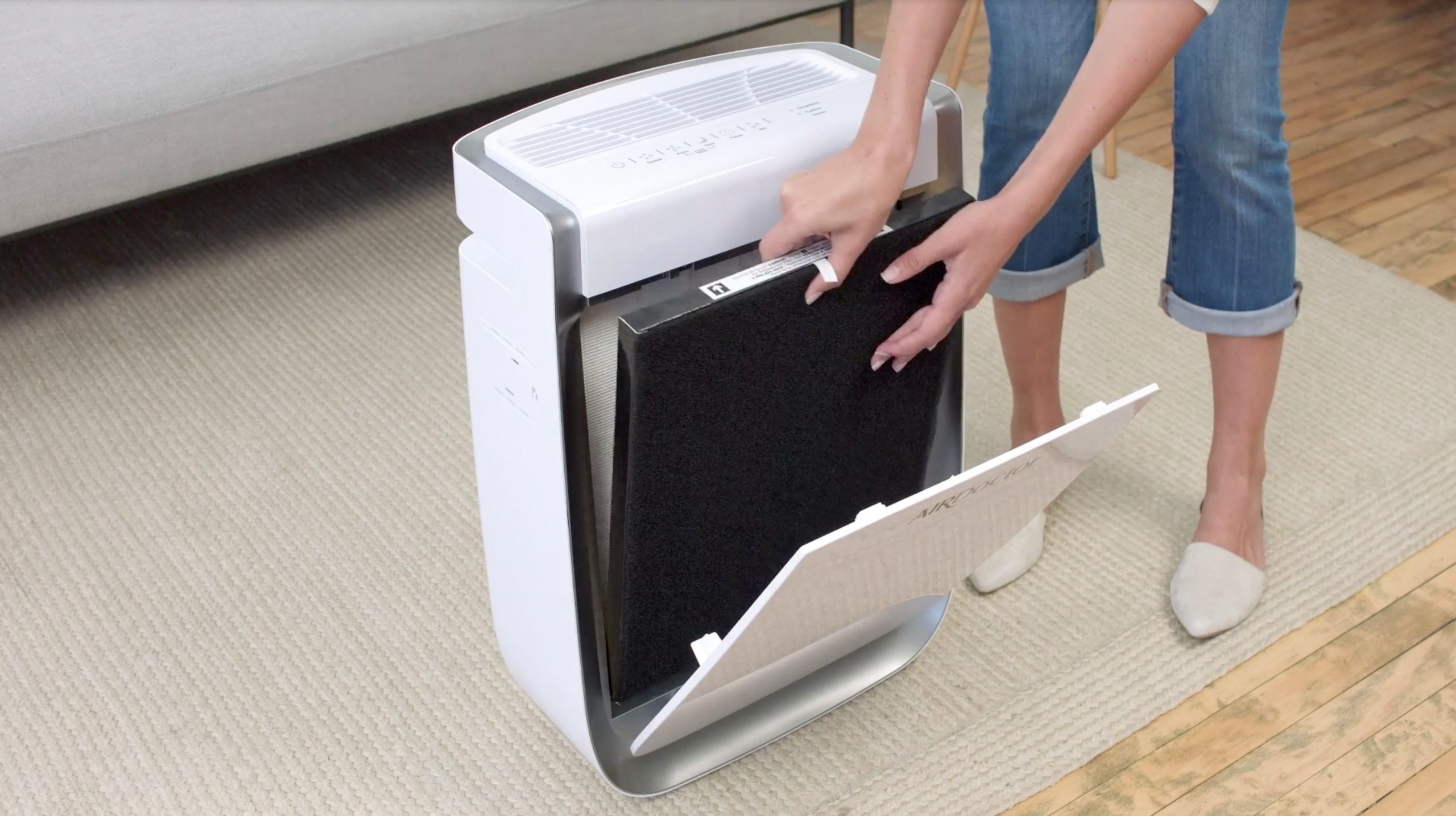
- Auto-Mode: Air Doctor units use a professional grade air quality particle sensor to constantly assess the air quality of a room. It immediately adjusts to remove excess particles from the air space. The unit will show a Blue ring light when air quality is good, orange for moderate, and red for poor.
- Light settings: There are a small handful of lights that run on an Air Doctor unit to provide information on its performance (ie. change filter alert or the ring lights that indicate air quality). These can be distracting at night when trying to sleep, so you can easily tap a setting to turn them off at anytime.
- *NEW* WIFI Options: When purchasing an Air Doctor, you may notice that every unit can be purchased with the option of WIFI. This will be of interest to some but not to others. I personally opt for WIFI free because I prefer to keep EMF exposure as low as possible in our home. That being said, the reports that you get sent to your phone on air quality, local weather and allergen monitoring, filter change alerts, indoor humidity and temperature monitoring, and the ability to control and adjust settings from anywhere is pretty neat. It’s up to you to balance pros and cons and determine if you prefer to purchase the original units or the new WIFI equipped version. I personally find that the original model without WIFI does a great job at alerting me to filter changes and shifting into auto mode by itself.
6. First set of Filters is included with Air Doctor Purifiers
All Air Doctor purifiers come with their first set of filters so you can unbox and immediately start purifying the air in your home.
What Size Air Purifier Should I Buy?
Air Doctor offers 4 different models of varying size and power. This can be helpful considering we all have different requirements when it comes to room sizing. The four models they carry are called: the 1000, 2000, 3000 and 5000. You want to be sure you’re choosing the correct unit. Here is a helpful comparison chart of each purifier below:
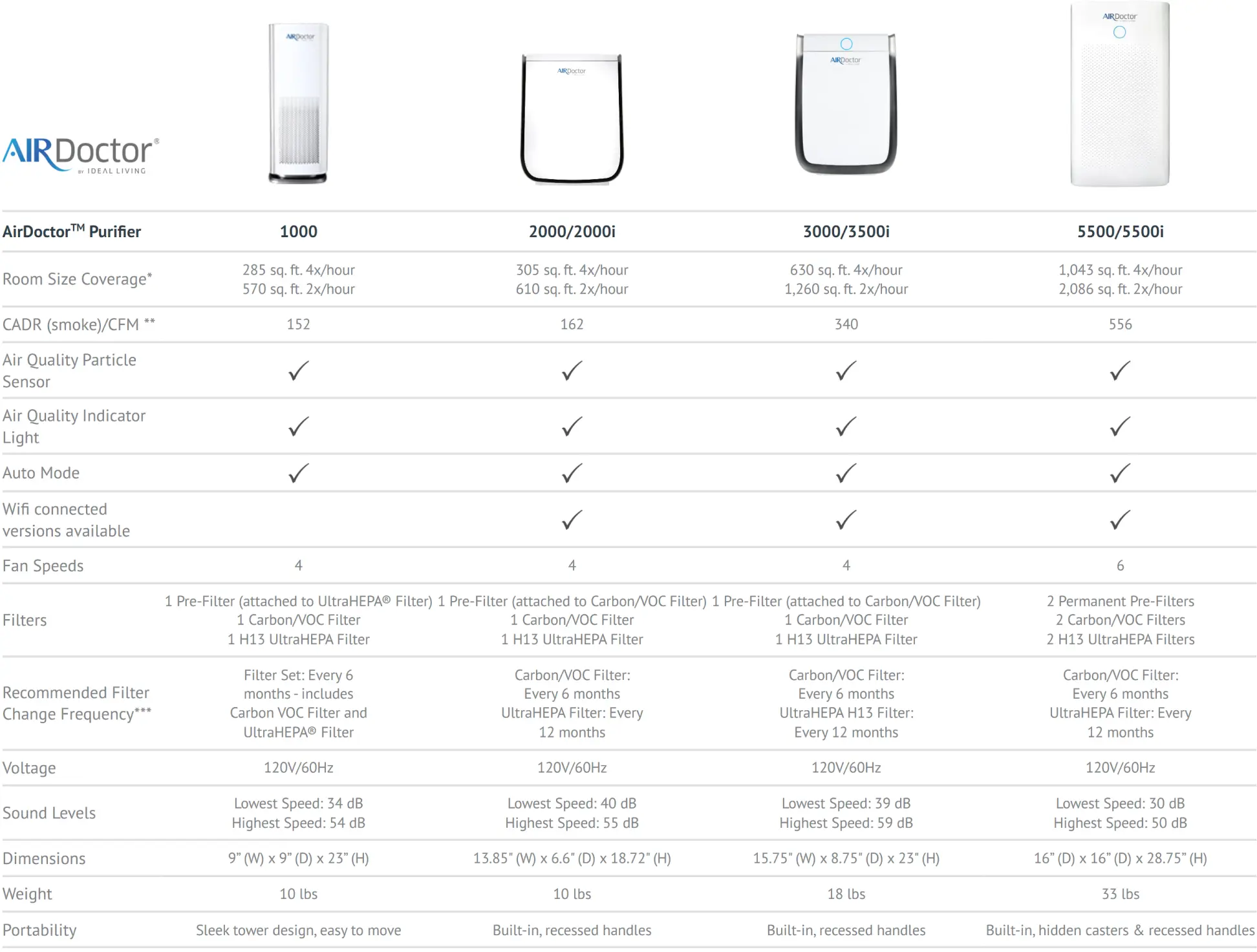
While the comparison chart gets into the nitty gritty and shares the exact square footage that each unit will cover, I wanted to share an idea of where I would keep each unit within my own home. Keep in mind, my home may be a different size than your home. It’s always good to reference the comparison chart incase you have larger rooms but a standard home may look as follows:
- AD1000: ‘Powerful purification for small rooms in your home’. The 2000 suits rooms like small bedrooms, nurseries, home offices, laundry rooms and more. It circulates the air in 285 sq. ft. 4x/hour or in 570 sq. ft. 2x/hour.
- AD2000: ‘Powerful purification for small rooms in your home’. The 2000 suits rooms like small to medium bedrooms, nurseries, home offices, laundry rooms and more. It circulates the air in 305 sq. ft. 4x/hour or in 610 sq. ft. 2x/hour.
- AD3000: ‘The Classic Air Doctor and original model.’ The 3000 suits most size bedrooms bedrooms, living rooms, kitchens and more. It circulates the air in up to 638 sq. ft. 4x/hour or in 1,274 sq. ft. 2x/hour.
- AD5000: The most powerful purifier yet also the quietest. It’s the perfect Air doctor for extra large spaces, high ceilings and open concepts. It circulates the air in 1,001 sq. ft. 4x/hour or in 2,001 sq. ft. 2x/hour.
You may be wondering, “what’s the difference between the 1000 and 2000 model”? While they are fairly similar in specifications, there are two differences between the models to help you decide which fits your needs best:
- Filter change requirements: The Air Doctor 1000 has one filter set that includes Ultra HEPA® and VOC Filters, which needs to be changed every 6 months. The Air Doctor 2000 includes 2 separate filters (one Ultra HEPA® filter which should be changed once a year, and one VOC filter which should be changed once every 6 months).
- Design: The Air Doctor 1000 is tower-shaped, allowing it to fit in certain corners. The Air Doctor 2000 comes in a classic box box shape, but could also fit in many corners due to its small size.
Price Breakdown & Air Doctor Discount Code
As I mentioned briefly, price tag was a major factor when I was looking at which air purifier to buy for our home. I went into this knowing that I didn’t want to find the very cheapest option off amazon that wouldn’t clean the air properly. I also didn’t want to spend thousands of dollars. I knew there had to be a level of reasonable compromise between quality and affordability. I was pleasantly surprised that Air Doctor provides state of the art professional grade technology. They truly took the best of the best filtering systems, layered them into aesthetically pleasing single units and then didn’t get greedy with profit margins.
In the interest of full transparency, 4 or 5 years ago I purchased my very first Air Doctor 3000 with my own funds. It was not gifted or discounted and I was not affiliated with the brand at the time. After being completely content with the quality of our own Air Doctor, I later reached out to them to see how I could be a part of sharing their products on my channels. I feel so lucky that they graciously offered a very generous exclusive discount to those who purchase via my page. I love that I can offer this to make this purchase even more affordable. I wanted to share those savings with you here:
Air Doctor 1000– THV Price $289 (Regular Price $399 – $110 off)
Air Doctor 2000– THV Price $279 (Regular Price $389 – $110 off)
Air Doctor 3000– THV Price $349 (Regular Price $629 – $280 off)
Air Doctor 5000– THV Price $699 (Regular Price $999 – $300 off)
** All WIFI units add $100 to cost but as I mentioned above, I don’t personally think this is necessary and I opt out of WIFI purifiers to reduce the amount of EMF exposure within my own home. **
To access these prices you simply just click through to the website HERE, the discounts will auto populate at checkout. If you have questions, never hesitate to reach out and feel free to subscribe below to get access to my wellness newsletter where I share tips, tricks, reviews, and sales on my favorite wellness products.
A Few Other Articles You May Enjoy:
- 10 Incredible Health Benefits of Bovine Colostrum
- 16 Health Benefits of Red Light Therapy
- Health Benefits of Beef Liver & Organ Meats
- Truly Free Review + Discount Code: Non Toxic Laundry Detergent
PIN this post to keep it saved


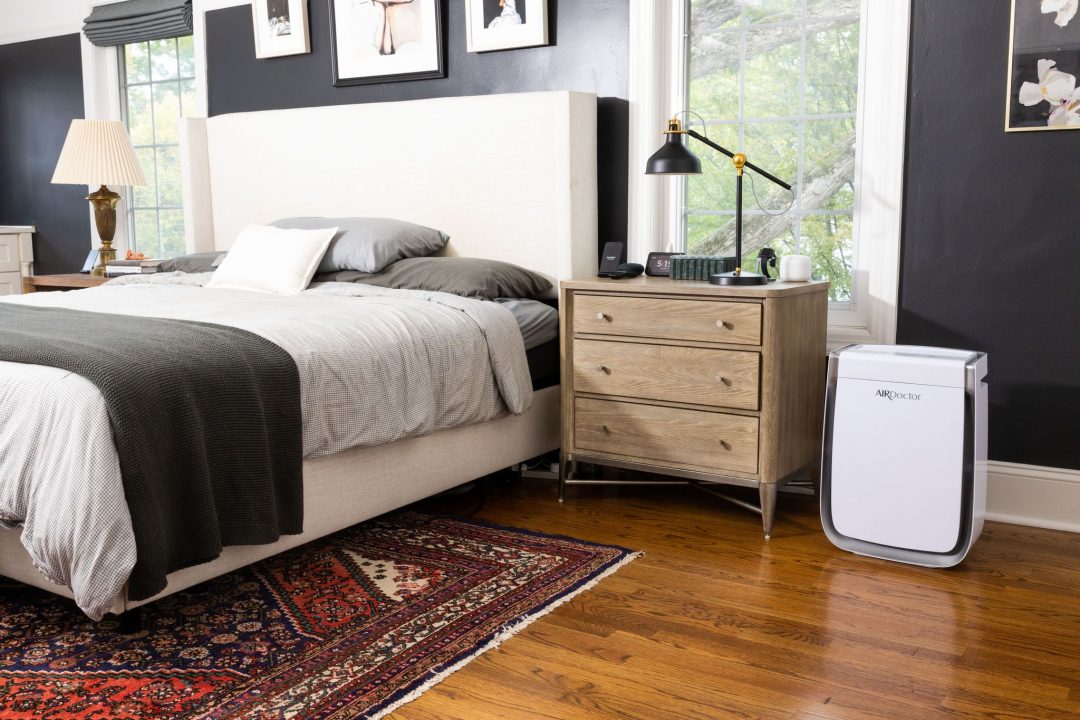
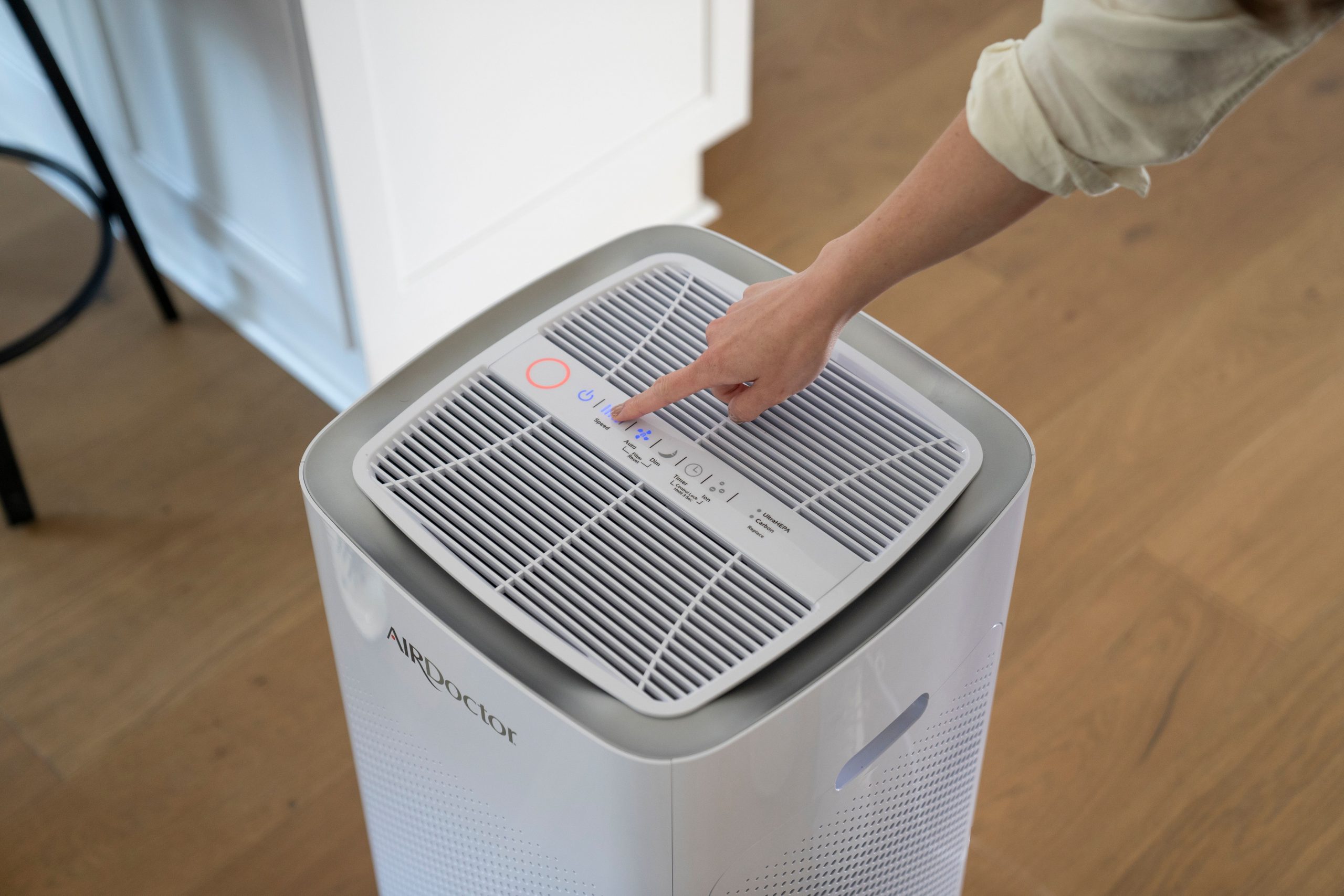
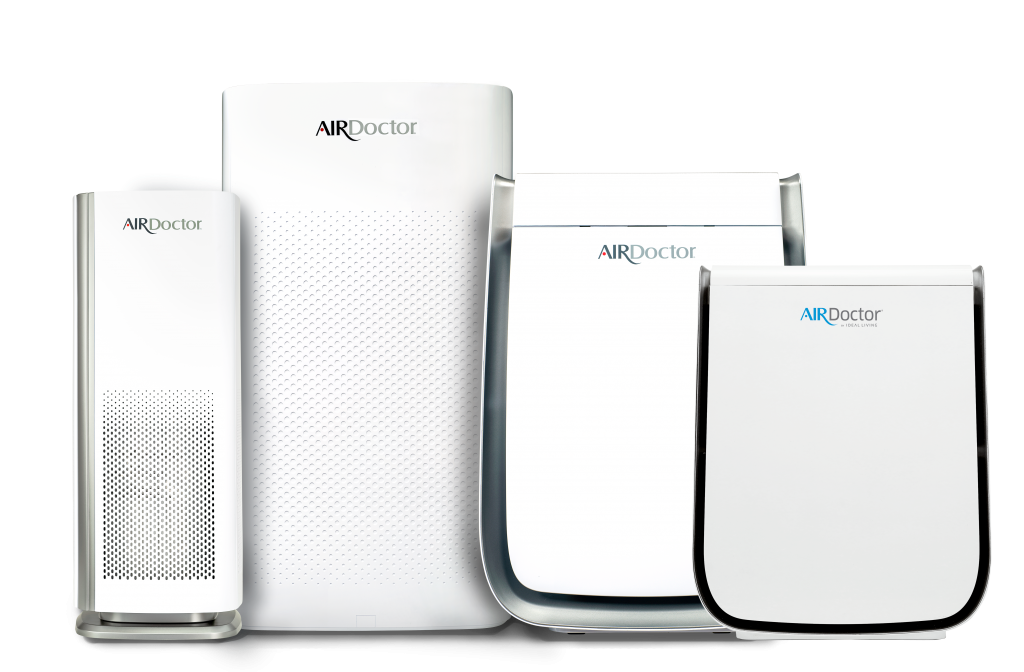



2 Comments
[…] to overall wellbeing. You can read more about how I ensure the best air quality in our home HERE. Another way I ensure we have healthy air is by only using natural candles. By using natural […]
[…] to overall wellbeing. You can read more about how I ensure the best air quality in our home HERE. Another way I ensure we have healthy air is by only using natural candles. By using natural […]